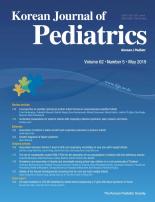Vitamin D has an important role in calcium and bone metabolism as well as controlling inflammatory responses. Vitamin D also regulates the growth and differentiation of several immune cell types, and inhibits immunomodulatory and anti-inflammatory responses. Vitamin D deficiency increases the loss of innate and adaptive immune function and susceptibility of autoimmune disease and infection, which results in an association with higher risk of sepsis, milk sensitization, respiratory infection or wheeze, type 1 diabetes, multiple sclerosis, and cardiovascular diseases [1]. The emerging role of vitamin D in preterm infants involves in pulmonary development and the regulation of lung maturation during the fetal period [2]. In animal studies, hypovitaminosis D during pregnancy tends to alter alveolar epithelial mesenchymal signaling, and reducing tracheal diameter, increasing airway resistance, and reducing lung compliance, which results in decreased lung function in fetal mice [3]. Activated vitamin D is involved in surfactant synthesis and secretion [3].
The major determining factor of neonatal vitamin D level at birth is maternal vitamin D status, as vitamin D transfers to the fetus during third trimester; this suggests that preterm infants are at higher risk of vitamin D deficiency than full-term infants. In Korea, a previous study reported vitamin D status in preterm infants at birth; over 90% of preterm infants had vitamin D deficiency or insufficiency [4,5]. Vitamin D levels in late pregnancy and cord blood were associated with the development of wheezing and lower respiratory tract infections in early childhood, the incidence of which could be reduced by vitamin D supplementation during pregnancy [6]. In preterm infants (gestational age ≤32 weeks), lower 25-hydroxyvitamin D (25-OHD) at birth increased the risk of oxygen requirement, use of positive-pressure ventilation in the delivery room, the need for assisted ventilation and the development of respiratory distress syndrome (RDS) [7,8]. Severe maternal and neonatal vitamin D deficiency was shown to increase the risk of bronchopulmonary dysplasia (BPD) [9].
The study by Kim et al. [10] published in the current issue is the first report of the association between low vitamin D levels at birth and neonatal morbidities of very-low-birth-weight (VLBW) infants in Korea. In this report, 80% of VLBW infants were vitamin D deficient or insufficient. They presented that the clinical factors associated with vitamin D deficiency at birth were season (spring and winter) at birth, older maternal age, and lower birth weight. The clinical outcomes of vitamin D deficiency at birth in VLBW infants were longer duration of hospitalization, longer period of mechanical ventilator and noninvasive oxygen therapy, higher frequency of surfactant therapy, and higher incidence of RDS, BPD and retinopathy of prematurity (ROP). Logistic regression analysis showed that vitamin D deficiency at birth was an independent risk factor of RDS and BPD. Vitamin D deficiency at birth was not correlated with mortality, sepsis, necrotizing enterocolitis (NEC), and other respiratory morbidities including pneumothorax and pulmonary hemorrhage. They did not include data of maternal vitamin D level or individual longitudinal changes in vitamin D status during hospitalization despite administering vitamin D to participants according to vitamin D status at birth; therefore, the role of maternal vitamin D level, postnatal vitamin D supplementation and duration of vitamin D deficiency associated with respiratory morbidities in preterm infants remains unclear in this report.
The American Academy of Pediatrics recommends 200–400 IU/day of vitamin D [11], and the European Society of Pediatric Gastroenterology Hepatology and Nutrition recommends 800–1,000 IU/day in newborns [12]. The optimal vitamin D dose for preterm infants is generally accepted as 200–800 IU/day. Fort et al. [13] compared serum 25-OHD concentrations at 28 days after vitamin D intakes of placebo, 200 IU/day, and 800 IU/day in extremely preterm infants (23.0–27.6 weeks of gestation). The 25-OHD concentrations of infants with an intake of 800 IU/day were higher than those of infants with an intake of placebo or 200 IU/day, but above the desired range of 20–60 ng/mL. There were no significant intergroup differences in mortality, rate of weight gain, duration of respiratory support, or neonatal morbidities including BPD, ROP, NEC, or intraventricular hemorrhage (IVH). Increasing the dose of vitamin D was not correlated with a reduction in neurodevelopment impairment or need for oxygen requirement or asthma medication at 2 years of age [14]. A previous randomized controlled trial [13,14] analyzed the association between 2-year outcomes and vitamin D status at birth but provided no information about 25-OHD levels or vitamin D supplementation between 28 days and 2 years of age. Although vitamin D status during pregnancy and at birth impacts neonatal lung maturation, changes in vitamin D status during the trial period may also be associated with respiratory morbidities given that the half-life of 25-OHD is about 2 weeks.
In Korea, the majority of preterm infants are at high risk of vitamin D deficiency. Kim et al. [10] reported an association between vitamin D deficiency and a high risk of respiratory morbidities in Korean preterm infants. The early supplementation of 800 IU/day of vitamin D may reduce the incidence of vitamin D deficiency during hospitalization in Korean VLBW infants [5] but was not associated with neonatal clinical outcomes. In conclusion, vitamin D status at birth may be associated with respiratory morbidities; thus, further studies should be needed to identify the optimal dose and duration of vitamin D supplementation to improve respiratory outcomes in Korean preterm infants.





 PDF Links
PDF Links PubReader
PubReader ePub Link
ePub Link PubMed
PubMed Download Citation
Download Citation


